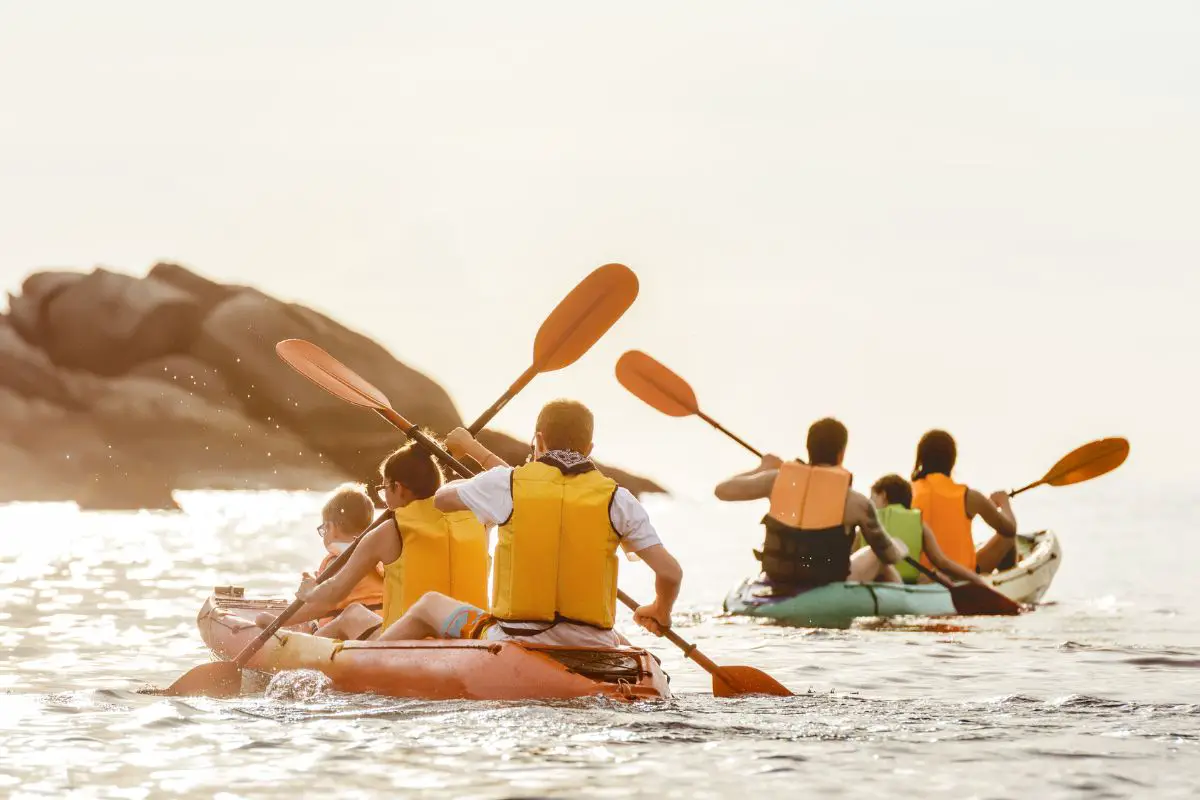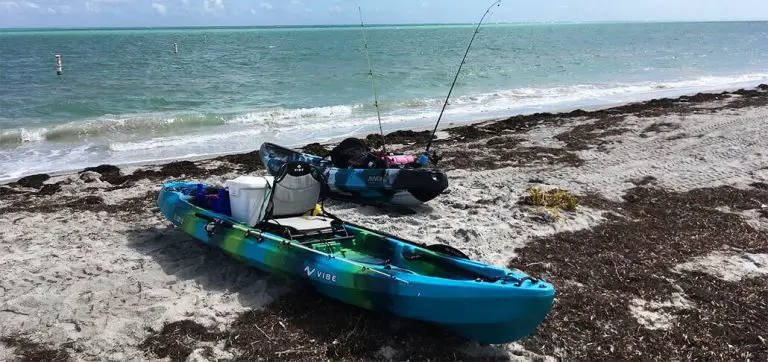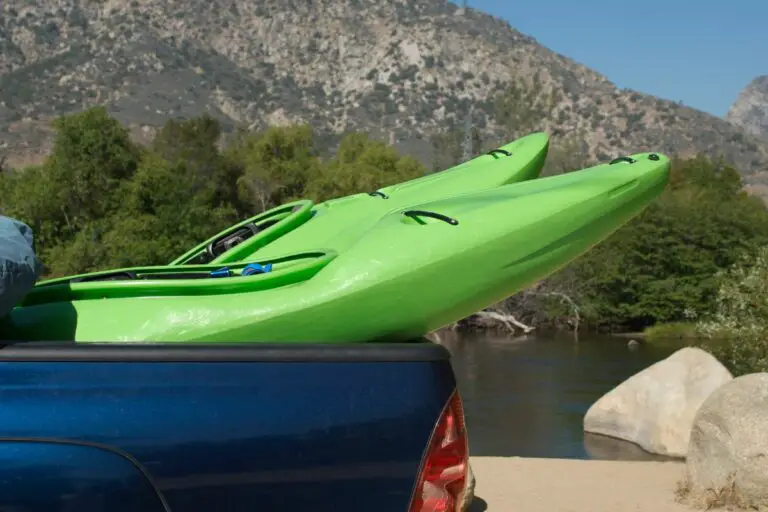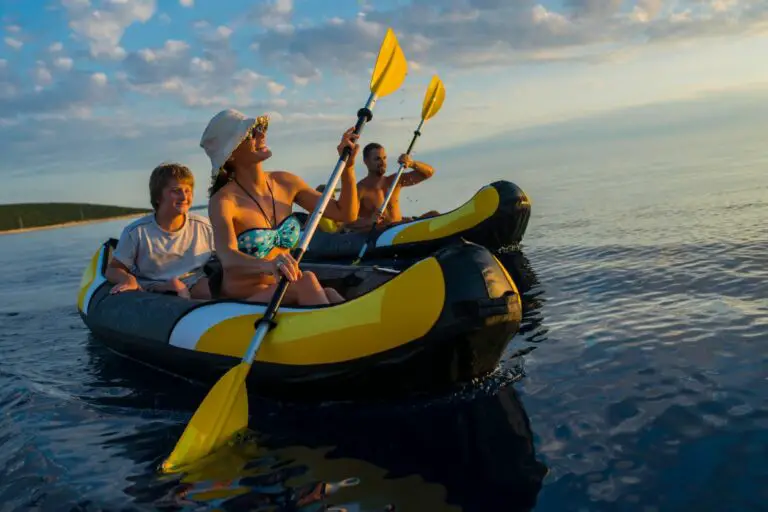Can Anyone Go Kayaking? A Complete Guide to Answer All Your Questions
Kayaking is a popular outdoor activity that offers a unique way to explore the beauty of water bodies such as rivers, lakes, and oceans.
However, many people wonder if kayaking is hard and if they can actually participate in this sport. So, can anyone go kayaking?
Anyone can go kayaking as long as they learn basic kayaking techniques, have the proper gear and equipment, and take the necessary safety precautions. However, certain conditions and circumstances may make kayaking harder or more challenging for some.
Keep reading to learn more about how hard kayaking is and the different circumstances under which you can or cannot go kayaking.
Table of Contents
Can Anyone Go Kayaking?
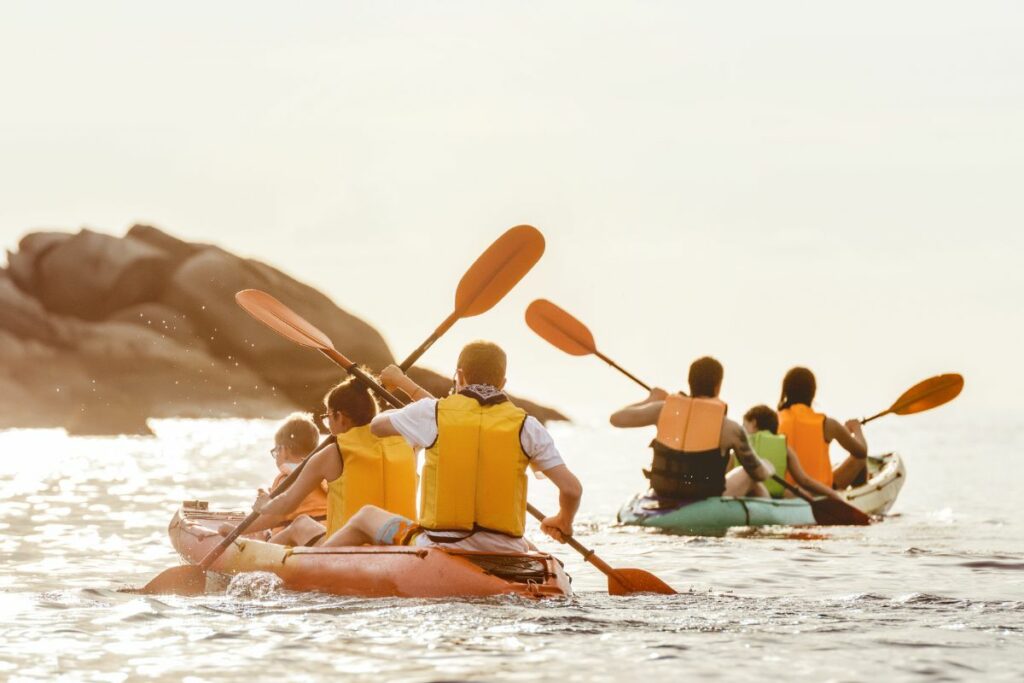
Generally, anyone can go kayaking regardless of age, gender, or skill level, as long as they learn some basic kayaking techniques, have the proper gear and equipment, and take the necessary precautions to stay safe out on the water.
Kayaking is not really a hard activity, but it can be physically demanding, especially if you are new to it. The level of difficulty of kayaking depends on several factors, including the type of water you are kayaking on, the weather conditions, and your level of experience.
The more experience you gain, the more you’ll find kayaking to be easy, enjoyable, and even rewarding, as it has many benefits for your physical health as well as mental health.
However, there are certain conditions and circumstances that may make kayaking harder or more challenging, and it’s important to be aware of them, so you can make an informed decision about whether or not you can go kayaking.
Can You Kayak Without Lessons?
While it’s possible to kayak without taking lessons, it’s generally recommended to take lessons before you start kayaking on your own, as kayaking involves certain techniques and safety protocols that are important to learn in order to have a safe and enjoyable experience on the water.
In a kayaking lesson, you’ll typically learn basic paddling techniques, how to properly enter and exit the kayak, how to handle the kayak in different water conditions, and important safety procedures.
If you’re interested in kayaking but haven’t taken lessons, it’s a good idea to find a reputable instructor or program in your area and sign up for a lesson or class.
Can You Kayak If You Can’t Swim?
It is possible to kayak if you can’t swim as long as you understand the risks and take appropriate safety measures.
If you’re planning on kayaking and you can’t swim, it’s crucial to wear a properly fitted and approved personal flotation device (PFD) at all times, which will help keep you afloat and may prevent you from drowning if you fall out of the kayak.
It’s also important to kayak in calm, flat water conditions and to stay close to the shore. Additionally, it’s a good idea to kayak with a partner or a group so that someone can help you in case of an emergency.
However, if you’re not comfortable with the idea of kayaking without being able to swim, it’s a good idea to learn how to swim before attempting kayaking.
Can You Kayak While On Your Period?
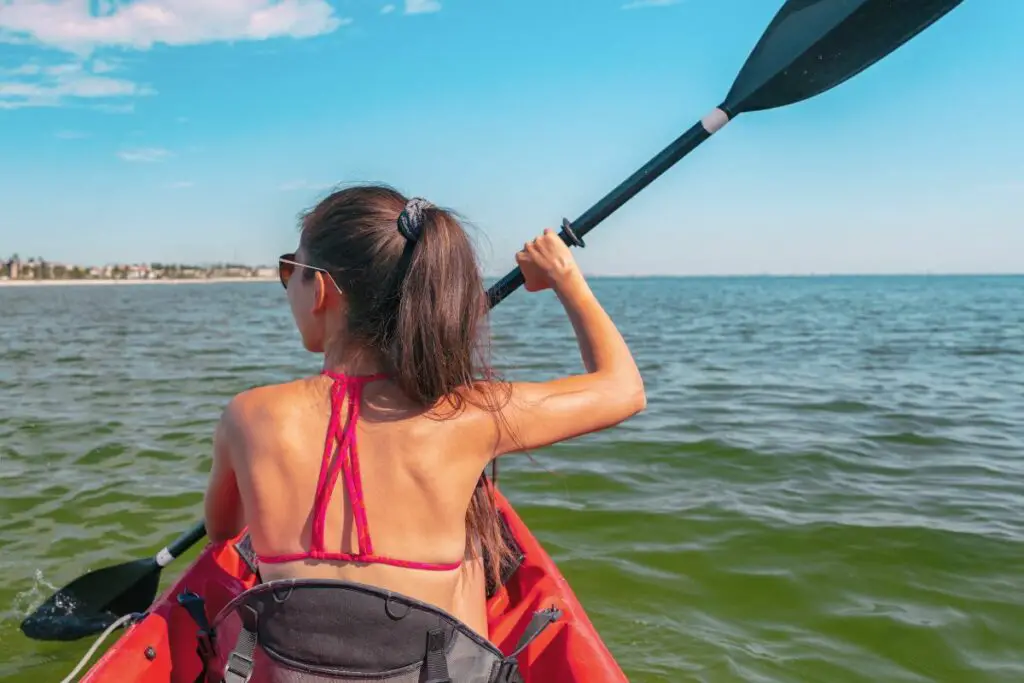
You can kayak while on your period. Menstruation should not prevent you from enjoying outdoor activities such as kayaking. However, it’s important to be prepared and take the necessary precautions to ensure comfort and hygiene while kayaking.
Firstly, using tampons or menstrual cups instead of pads while kayaking is a good idea. Pads can become uncomfortable and may shift around while paddling. Tampons or menstrual cups are more secure and will allow you to move around comfortably.
It’s also a good idea to bring extra tampons or menstrual cups with you in case you need to change them while kayaking. You may want to store them in a waterproof bag to keep them dry. Additionally, wearing dark-colored clothing can help you feel more comfortable and confident while kayaking.
Can You Kayak While Pregnant?
It’s generally recommended that pregnant women avoid kayaking, particularly during the second and third trimesters, as kayaking involves physical exertion, balance, and the risk of falling or getting thrown off the kayak, which can potentially harm both the pregnant person and the developing fetus.
Additionally, kayaking involves exposure to water, which can increase the risk of infections or other health concerns during pregnancy.
If you’re pregnant and want to kayak, it’s important to talk to your doctor or healthcare provider first to determine if it’s safe for you and your pregnancy. They may advise you to avoid kayaking altogether, or they may provide specific guidelines and safety precautions to follow.
If your doctor does give you the green light to kayak while pregnant, it’s important to take extra precautions to stay safe.
Can You Kayak with A Baby?
It’s generally not recommended to kayak with a baby, as it involves risks such as falling or capsizing, which can be dangerous for a baby.
Additionally, babies are too young to wear personal flotation devices (PFDs), and they may not be able to tolerate the kayak’s water, noise, and movements.
The American Academy of Pediatrics recommends that babies be at least 1 year old before being taken on a boat, including kayaks. So, it’s best to wait until your baby is older and able to tolerate the conditions of kayaking.
Can You Kayak with a Pet?
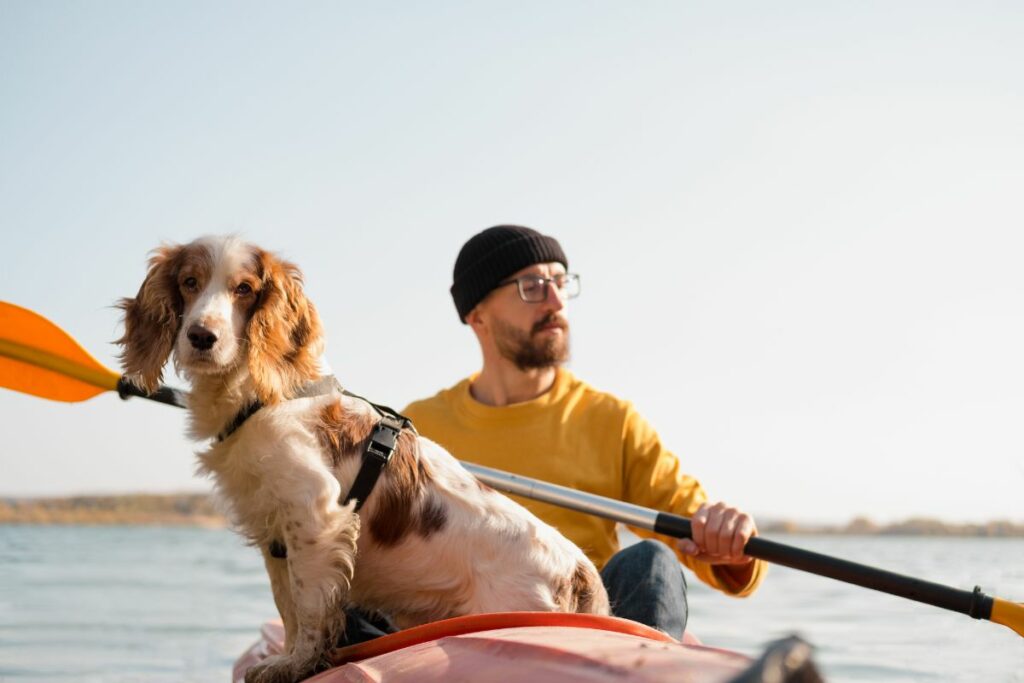
You can kayak with a pet, but it’s important to take certain precautions to ensure their safety and comfort.
Before heading out onto the water, it’s important to get your pet comfortable with the kayak. You need to allow your pet to explore the kayak on land and get used to the kayak’s sights, sounds, and movements.
Also, like humans, pets should wear a properly fitted life jacket or personal flotation device (PFD) while kayaking.
Finally, watch for signs of discomfort or stress in your pet, such as panting, whining, or trying to escape from the kayak. If your pet seems uncomfortable or distressed, returning to shore is best.
Can You Kayak If You’re Overweight?
You can kayak if you’re overweight. Kayaking is a low-impact activity that can be enjoyed by people of all shapes and sizes as long as you have the proper equipment and safety gear.
However, it’s important to note that being overweight can make it more challenging to get in and out of the kayak and move around.
When selecting a kayak, you need to make sure that the weight capacity that can accommodate your weight and any additional gear or equipment you’ll be carrying. You also need to consider the dimensions of the kayaks, as wider kayaks can provide more stability and may be more comfortable for larger individuals.
Additionally, if you have any health concerns or medical conditions related to your weight, it’s a good idea to talk to your doctor before starting any new physical activity, including kayaking.
Can You Kayak While Drunk?
It is not safe to kayak while under the influence of alcohol or drugs. Kayaking requires concentration, balance, and coordination, which can be impaired by the effects of alcohol or drugs, increasing the risk of accidents, injuries, and drowning.
Operating a kayak while intoxicated or impaired is also illegal and can result in fines, legal charges, and even imprisonment, depending on the severity of the situation.
Can You Kayak on Meds?
You may be able to kayak on meds, but it depends on the kind of medication and how it affects you. Some medications may impair your balance, coordination, or ability to concentrate, which can be dangerous when kayaking.
It’s important to consult with your doctor or pharmacist to understand how your medication may affect your ability to kayak safely.
If your medication may impair your ability to kayak, it’s important to consider the risks and take precautions to ensure your safety, such as avoiding kayaking altogether while on certain medications or adjusting your dosage or timing of medication to minimize any potential side effects.
Can You Kayak At Night?

You can kayak at night, but keep in mind that kayaking at night presents additional risks and challenges that aren’t present during the day, so it’s important to take extra precautions to ensure your safety.
The most important thing is to light the kayak properly using navigation lights and a flashlight or headlamp. This will help you see where you are going and make you visible to other boaters.
You also need to wear a properly fitted personal flotation device. This is required regardless of the time of day, but it’s especially important at night when visibility is reduced.
Additionally, make sure to check the weather forecast before heading out and avoid kayaking in unfamiliar or potentially hazardous areas. It’s also a good idea to kayak with a friend to provide additional safety and support.
Can You Kayak When It’s Cold?
You can kayak when it’s cold, but cold weather can present additional risks, such as hypothermia, and it’s important to take extra precautions to ensure your safety and comfort.
Here are some tips for kayaking when it’s cold:
- Dress in layers of warm, moisture-wicking clothing that can be easily removed or added as needed.
- Avoid cotton clothing, as it can trap moisture and make you colder.
- Wear a drysuit and other appropriate cold-water gear like gloves, a hat, and waterproof footwear to help protect you from the cold water.
- Try to stay as dry as possible while kayaking in cold conditions.
- Bring a thermos of hot drinks and some high-energy snacks to help keep you warm and comfortable.
Can You Kayak When It’s Raining?
You can kayak when it’s raining, but it can present additional challenges, such as reduced visibility and slippery surfaces, so it’s important to take some extra precautions to ensure your safety and comfort.
Here are some tips for kayaking in the rain:
- Wear waterproof or water-resistant clothing, such as a rain jacket and pants, to keep yourself dry.
- Avoid cotton clothing, which can absorb water and make you feel colder.
- Bring a dry bag or container to store any electronics or other items that can’t get wet.
- Be extra vigilant and aware of your surroundings, as rain can reduce visibility, making it more difficult to see other boaters, hazards, or obstacles.
- Wet surfaces can be slippery, so be careful when getting in and out of your kayak, as well as when walking on docks or other surfaces.
Can You Kayak When It’s Windy?
You can kayak when it’s windy, but it’s important to take extra precautions to ensure your safety and enjoyment.
Here are some tips for kayaking in windy conditions:
- Before heading out, check the weather forecast for wind speed and direction. It’s generally best to avoid kayaking in high winds, but if you do go out, be aware of the conditions and plan your route accordingly.
- When paddling in windy conditions, it’s important to adjust your paddling technique to account for the wind. You may need to use more power on one side or use a different stroke to maintain your course.
- Be extra vigilant and aware of your surroundings, as the wind can affect your visibility and make it more difficult to see other boats, hazards, or obstacles.
- Consider using a wider kayak or a sit-on-top kayak to provide more stability and help you stay upright in windy conditions.
- Dress in layers and wear appropriate gear, such as a windbreaker or spray skirt, to stay warm and dry.
- Avoid kayaking in open water or areas with strong currents or waves when it’s windy. Stick to sheltered areas or protected coves instead.
For a complete guide on when you should really pack it and go home, check out our guide on when not to go kayaking here, and I highly recommend taking the advice there as it can help you avoid a lot of trouble.
Conclusion
In conclusion, kayaking is a great outdoor activity that almost anyone can enjoy. While some certain conditions and circumstances may make kayaking harder or more challenging, with proper preparation and precautions, many of these challenges can be overcome.
Kayak your way to Freedom
- On a budget? Check out the best fishing kayaks under $500 here and the best Fishing Kayaks under $1,000 here. Or Check the best Cheap Kayaks here.
- Going fishing? Here are the best Ocean fishing kayaks, and here are the best River Fishing Kayaks.
- You can also find the best Fly Fishing Kayaks here and the best Bass Fishing Boats here.
- A bit experienced? Check out the best modular kayaks here and the best tandem fishing kayaks here.
- Looking for something special? Check out my favorite Ducky kayaks here.
- Navigate your way with these awesome and beginner-friendly Kayak compasses.
- Going Hunting? These Duck hunting kayaks will give you an unfair advantage!
- Have a need for speed? These motorized kayaks will get you moving.
- Protect yourself from the sun with these Kayak shades, and make your kayak more comfortable with these Kayak seats.
- Keep your feet dry and warm with these superb Kayaking shoes.
- Going Kayaking in cold water? Stay warm with these Kayaking gloves.
- Paddle Less, Fish More with the Best Kayak Motors
- Looking to get a trolling motor on your kayak? Check out the best kayak trolling motor mounts here.
If you like this article, please share it or pin it, you can find the share buttons below. We will really appreciate it ❤️

